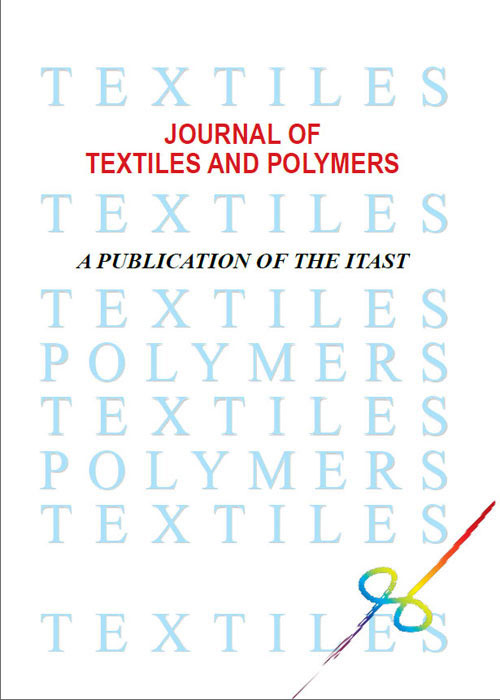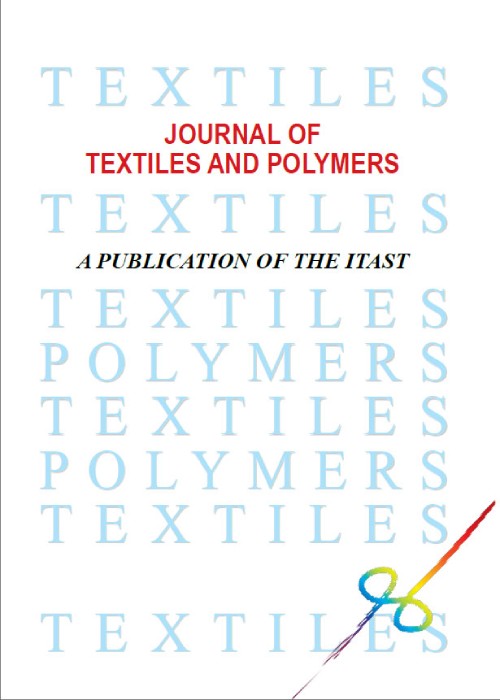فهرست مطالب

Journal of Textiles and Polymers
Volume:8 Issue: 2, Spring 2020
- تاریخ انتشار: 1399/03/12
- تعداد عناوین: 7
-
-
Pages 1-14
Experimental and statistical properties of bi-shrinkage yarns (BSY) were studied by combining multifilament yarns of poly(ethylene terephthalate) containing partially oriented yarn and fully drawn yarn with different finenesses. In this procedure, different twists per meter (500, 1000, and 1500 tpm) were applied to different BSYs. Then tensile, shrinkage, and appearance properties of the samples were analyzed. The appearance properties of the BSYs showed that they are very similar to multifilament textured yarns. The most important factor affecting the BSYs properties is the filaments’ number of yarns. The best mechanical, shrinkage, and appearance properties were observed in the samples containing two components with the same number of filaments (regular or microfilament yarns). Also, statistical studies showed the most important factor affecting the BSYs properties was filaments’ number of yarns. Moreover, the number of twists per meter of BSY’s is an effective parameter.
Keywords: i-shrinkage yarn, bulk, physical properties, poly(ethylene terephthalate), partially oriented yarn (POY), fully drawn yarn (FDY), microfilament yarn -
Pages 15-22
The present work explores a facile route to prepare a durable conductive fabric by using reduced graphene oxide and polypyrrole. Prior to coating of active materials, polyester surface experienced a modification which resulted in high uptake of materials. Then, dip-coating approach was used to deposit graphene oxide on the modified polyester. After reduction of graphene oxide, polypyrrole particles grew on the fabric surface through an in situ polymerization method. SEM, XRD, FTIR, and TGA were employed to investigate the morphology and chemical structure of the samples. A high electrical conductivity of 0.98 S.cm-1 was obtained which arises from establishing the numerous conduction routes in the structure. A mere decrease in conductivity after 20 laundry cycles confirms the excellent washing durability of the conductive fabric. Moreover, a high specific capacitance of 8.3 F.g-1 was recorded for this fabric by cyclic voltammetry in a three-electrode measurement system.
Keywords: polyester, reduced graphene oxide, polypyrrole, conductive fabric, surface modification, alkaline hydrolysis -
Pages 23-32
In this study, the application of mixed oligomers containing urea linkage as flame retardant and antibacterial agent in jute fabric was investigated. The mixed oligomers were produced using various molar ratios of urea and other inorganic acids such as sulfamic and phosphorous acid at a specific temperature. The reactions occurred in melt state in the temperature range of 130-150 °C. An aqueous solution of 50% of products was applied to the jute fabric with 80% wet pick up, then dried at 80 °C and cured at 170 °C for 2 min. The chemical structures of the new materials were studied using FTIR. The SEM micrograph of the surface of the specimens was presented along with the elemental analysis information using EDAX technique. The thermal decomposition analysis results by applying DSC and TGA techniques were also reported. The limited oxygen index of treated samples showed high level of fire resistant improvement with desirable wash durability. Antibacterial properties of treated samples were indicated against Staphyloccus aureus and Escherichia colibacteria. In conclusion, it was found that the amount of phosphorus plays a significant role in antibacterial and flame retardant performance of jute fabric. The high level of limited oxygen index (0.41%) was measured for sample treated with the compounds prepared from 2 moles sulfamic acid, 3 moles phosphorous acid, and 8 moles of urea.
Keywords: flame retardant, jute fabric, oligomer, finishing -
Pages 33-40
Since poly(lactide-co-glycolic acid) (PLGA), as a biodegradable material, is a hydrophobic polymer which might lead to the incoherence of optimal growth of cells on the scaffold, the scaffold surface modification can promote the cell growth and proliferation. In this study, two methods including structural modification and plasma treatment were employed to improve the surface properties and epithelial kidney cells (Vero) culture efficiency for the PLGA nanofibrous scaffolds. Moreover, the physical, and chemical properties of the modified scaffolds were characterized. Plasma treatment enhances surface hydrophilicity and structural modification improves physical properties of surface such as fiber diameter, surface porosity and alignment index. It was found that the plasma-treated scaffold is more hydrophilic compared to the structurally-modified and non-treated scaffolds. From the ATR-FTIR spectra of the samples, it was observed that the extent of C=O and C-O groups was increased in the plasma-treated samples in comparison with the other groups. Furthermore, in-vitro studies demonstrated that, despite the greater hydrophilicity of the plasma-treated scaffold, both of modified scaffolds enhanced the cell growth and proliferation of Vero cells. In conclusion, the structurally-modified scaffolds have shown a promising potential to improve the cell proliferation as compared with the plasma-modified scaffolds.
Keywords: electrospun nanofibrous scaffold, hydrophilicity, surface modification, structural modification, plasma-treated scaffold -
Pages 41-51
.The main aim of this study is to obtain a detailed information about textile string vibration and the effect of physical properties changes on it. This is based on the fact that modal parameters are the functions of physical properties. Video cameras propose the unique capability of collecting high density spatial data from a distant view and supply a reliable method for measuring vibrations and displacements in structures. They could be employed as inspection sensors because of their normal use, ease, and low cost. In this research, some laboratory equipment with a high-speed digital camera was designed to measure the vibration behavior of polypropylene monofilaments. The vibration was recorded by the high-speed camera at all the points of the string, and video processing was done to extract the free decays. The natural frequency, amplitude and phase were obtained by the Fourier series. The logarithmic decrement and the damping coefficient for monofilaments were calculated. The experimental results were compared to the results of a theoretical model for a plucked string with viscous damping, and the vibration properties of monofilaments were obtained. As the results showed, the theoretical model could successfully predict the vibration behavior of the filaments with error less than 23%. The trend of changes in the monofilament physical properties was easily specified based on the trend of the variations in the damping coefficient and the natural frequency. It was found that an increase in the monofilament linear density would cause a decrease in the damping coefficient and its natural frequency.
Keywords: vibration analysis, monofilament, high-speed camera, computer vision -
Pages 53-63
This paper is concerned with the study of edgewise compression properties of newly developed sandwich panels denoted as 3D integrated woven sandwich composites (IWSCs). IWSC panels consist of two fabric faces that are interwoven by pile yarns and therefore, a very high skin-core debonding resistance is obtained. To qualify the mechanical properties of this structure, in this study, 3D woven samples with different pile heights and pile distribution densities were fabricated and then after the impregnation by resin, the effect of panel thickness, pile density, sample size, and types of resin on the edgewise compression behavior of IWSC panels were experimentally investigated. The results showed that edgewise compression properties of IWSC panels are increased with the increase of core heights as well as core pile density. Compared with the core height of 20 mm (H1), the peak load values of 30 mm panel thickness (H2) increase between 18 and 36%. Also, as the pile density increases from 2.1 cm-2 (D1) to 4.3 cm-2 (D3), the peak load values of samples increases about 6% to 14%. Furthermore, the composite produced by epoxy resin showed about 300% better compression properties than the composite fabricated by polyester resin. Warp and weft direction properties as well as size dependency of IWSC panels in edgewise compression test were also studied. The difference between the maximum load values for the warp and weft directions in the samples varies from 10% to 40%
Keywords: hree-dimensional woven fabric, edgewise compression, glass fabric, sandwich panel, composite -
Pages 65-73
Under constant strain, there is a decreased stress with time in viscoelastic materials, which is called stress relaxation. Textiles experience various long lasting deformations during manufacture and application. Consequently, stress relaxation occurs in these materials. This phenomenon can cause disturbances in textile performance in technical applications such as surgical mesh, pressure garments, varicose stockings, pressure bandages, etc. Thus, by considering the factors affecting stress relaxation of the fabric, the ability to design and produce appropriate products increases. In the present study, net warp knitted fabrics with five different structures including Tricot, Pin hole-net, Sandfly, quasi-Sandfly, and quasi-Marqussite have been produced and the effect of fabric structure on the stress relaxation of the fabrics in the course and wale directions have been investigated. To investigate the stress relaxation of the fabrics, a new index, named stress relaxation index was introduced. This index is obtained by multiplication of initial stress by the porosity of the fabric divided to the mass per unit area of the fabric. The results demonstrated that fabric structure has remarkable effect on the stress relaxation of the fabrics, and by increasing the stress relaxation index, stress relaxation of the fabric in both directions increases. Fabrics with Pin hole-net and quasi-Marqussite structures showed the highest and lowest stress relaxation in the course direction, respectively. Meanwhile, fabrics with Tricot and Sandfly structures exhibited the highest and lowest stress relaxation in the wale direction, respectively.
Keywords: stress relaxation, warp knitted, fabric structure, net fabric


